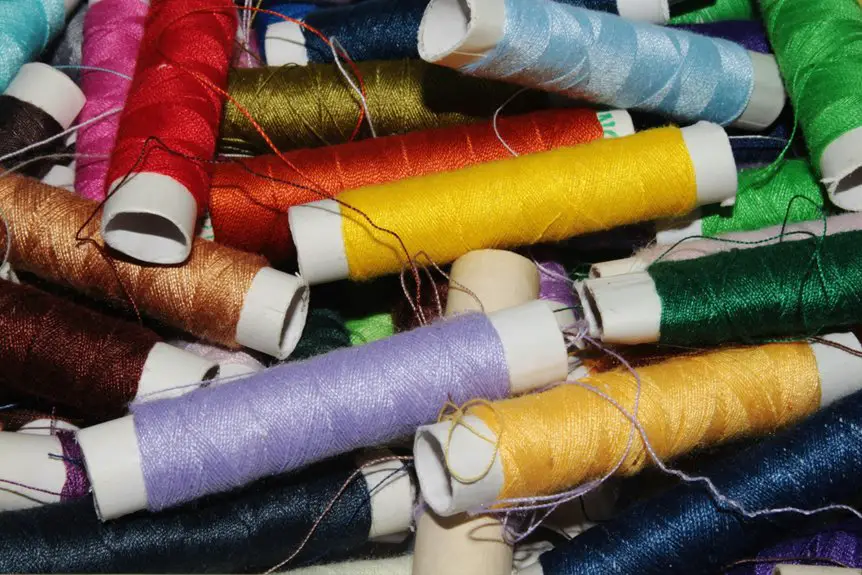It’s funny how you might reach for your favorite cotton shirt on a hot day, only to realize it doesn’t feel as cool as you expected. You probably wonder if there’s a better option out there, like rayon, which claims to keep you cooler. But what exactly makes one fabric more breathable or comfortable than the other? Let’s explore how these materials handle heat and moisture differently to see which truly helps you stay comfortable.
Table of Contents
Key Takeaways
- Rayon’s smoother fibers and better airflow enhance breathability, keeping you cooler than cotton.
- Rayon conducts heat away from the body faster, providing a cooler sensation against the skin.
- Rayon absorbs and evaporates moisture quickly, preventing dampness and maintaining dryness.
- Cotton traps moisture longer, which can cause a warmer, damp feeling during heavy sweating.
- Blends of rayon and cotton offer improved breathability and moisture-wicking for better temperature regulation.
Breathability and Cooling Properties of Rayon and Cotton
Although both rayon and cotton are popular choices for warm-weather clothing, they differ considerably in breathability and cooling properties.
You’ll find that rayon’s fiber structure is more uniform and smoother, allowing air to flow more freely through the fabric. This enhances its breathability, helping you stay cooler when temperatures rise.
Cotton, on the other hand, has a more irregular fiber structure with natural twists, which can trap air and moisture.
When it comes to thermal conductivity, rayon tends to conduct heat away from your body faster than cotton, making it feel cooler against your skin.
Comfort and Texture Differences Between Rayon and Cotton
When you wear rayon, you’ll notice its silky smooth texture immediately, which feels soft and lightweight against your skin. Cotton, on the other hand, offers a more natural, slightly coarse feel that some find comforting and breathable. This texture comparison plays a big role in comfort levels, especially in hot weather. Rayon tends to drape better, giving you a cooler sensation, while cotton provides a familiar, breathable touch.
| Feature | Rayon |
|---|---|
| Texture | Silky, smooth |
| Weight | Lightweight |
| Comfort Levels | Soft, cool against skin |
| Breathability | Good but less airy than cotton |
| Feature | Cotton |
| Texture | Natural, slightly coarse |
| Weight | Moderate |
| Comfort Levels | Breathable, familiar |
| Breathability | Excellent |
Both fabrics differ in feel and comfort, so choose what suits your skin best.
Durability and Care Considerations for Both Fabrics
Since you’ll want your clothes to last and stay looking good, understanding the durability and care of rayon and cotton is essential.
In a durability comparison, cotton generally holds up better over time, while rayon tends to weaken when wet.
To care for both fabrics effectively, follow these care instructions:
- Wash cotton in warm water for sturdiness; rayon prefers cold water to avoid damage.
- Avoid wringing rayon to prevent fabric distortion; cotton can handle gentle twisting.
- Air drying is best for rayon to maintain shape; cotton can tolerate machine drying on low.
- Iron cotton on high heat, but keep rayon on a low setting to prevent burns.
Moisture Management and Its Impact on Cooling
Because moisture management plays a key role in how fabrics keep you cool, understanding how rayon and cotton handle sweat and humidity is essential.
Rayon offers excellent moisture absorption, drawing sweat away from your skin quickly. Its high evaporation rates help moisture dry faster, which can keep you feeling cooler during hot, humid conditions.
Cotton also absorbs moisture well, but it tends to hold onto it longer, slowing down evaporation. This can leave you feeling damp and less comfortable when you sweat heavily.
If you want a fabric that manages moisture efficiently, rayon’s quick-drying properties give it an edge. However, cotton’s natural breathability still makes it a solid choice if you prefer a softer feel, even if it takes a bit longer to dry.
Benefits of Cotton and Rayon Blends for Temperature Regulation
Combining cotton and rayon brings together the best of both fabrics, enhancing temperature regulation beyond what either can offer alone.
Blending cotton and rayon creates fabrics that regulate temperature better than either fiber alone.
When you choose blends, you get:
- Improved breathability, allowing heat to escape efficiently.
- Enhanced moisture-wicking, keeping your skin dry and cool.
- Softer fabric feel, increasing comfort during hot days.
- Stylish versatility, aligning with current fashion trends.
These blends also address sustainability concerns better than pure rayon, as cotton reduces reliance on chemically intensive fibers.
By opting for cotton-rayon blends, you enjoy cooler wear without sacrificing style or environmental responsibility. This makes them ideal for anyone wanting breathable, fashionable clothing that performs well in warm weather.
Frequently Asked Questions
Are Rayon and Cotton Fabrics Hypoallergenic?
You shouldn’t worry much about rayon allergies since rayon is generally hypoallergenic, but some people might react to chemicals used in processing. Cotton’s natural fibers usually reduce cotton sensitivities, making it a safer choice if you’re sensitive.
How Do Rayon and Cotton Compare in UV Protection?
As they say, “prevention is better than cure.” You’ll find cotton offers better UV absorption, shielding you more during sun exposure, while rayon lets more UV rays through, so cotton’s generally safer for sun protection.
Which Fabric Is Better for Eco-Friendly Fashion Choices?
You’ll find cotton better for eco-friendly fashion choices since it often comes from sustainable sourcing and is biodegradable. Rayon’s production can involve chemicals, so it’s less eco-friendly despite being biodegradable too.
Can Rayon or Cotton Cause Skin Irritation in Sensitive Individuals?
You’d think rayon irritation and cotton sensitivity would never bother you, but sensitive skin can react to both! Rayon’s chemical processing and cotton’s natural fibers might cause redness or itching, so always test before wearing.
How Do These Fabrics Perform in Terms of Color Fading Over Time?
You’ll notice that cotton generally offers better color retention and fabric longevity, resisting fading longer. Rayon tends to fade quicker and may wear out sooner, so cotton’s your go-to if you want lasting vibrant colors.
- Where to Buy Sherpa Suede Fabric - July 12, 2025
- How to Draw or Illustrate the Texture of Suede Fabric - July 12, 2025
- What Is Baseball Suede Leather Fabric? - July 12, 2025







